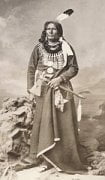Ponca Indians. One of the five tribes of the so-called Dhegiha group of the Siouan family, forming with the Omaha, Osage, and Kansa, the upper Dhegiha or Omaha division. The Ponca and Omaha have the same language, differing only in some dialectic forms and approximating the Quapaw rather than the Kansa and Osage languages.
The early history of the tribe is the same as that of the other tribes of the group, and, after the first separation, is identical with that, of the Omaha. After the migration of the combined body to the mouth of Osage river the first division of the Omaha group took place, the Osage settling on that stream, and the Kansa continuing up Missouri river, while the Omaha and Ponca crossed to the north side. The course of the latter is given from the tradition recorded by J. O. Dorsey 1 as follows: The Omaha and Ponca, after crossing the Missouri, ascended a tributary of that river, which may have been Chariton River, and finally reached the pipestone quarry in south west Minnesota. All the traditions agree in stating that the people built earth lodges or permanent villages, cultivated the soil, and hunted buffalo and other animals. When game became scarce they abandoned their villages and moved north west. On reaching a place where game was plentiful, other villages were built and occupied for years. Thus they lived and moved until they reached the pipestone quarry. After reaching Big Sioux river they built a fort. The Dakota made war on the Omaha and their allies, defeating them and compelling them to flee south west until they reached Lake Andes, South Dakota. There, according to Omaha and Ponca tradition, the sacred pipes were given and the present gentes constituted. From this place they ascended the Missouri to the mouth of White River, South Dakota. There the Iowa and Omaha remained, but the Ponca crossed the Missouri and went on to Little Missouri river and the region of the Black hills. They subsequently rejoined their allies, and all descended the Missouri on its right bank to the month of Niobrara River, where the final separation took place. The Ponca remained there and the Omaha settled on Bow Creek, Nebraska, while the Iowa went down the Missouri to the site of Ionia, Dixon County, Nebraska. The Yana, who on Marquette’s autograph map (1673) are placed near the Omaha, apparently on the Missouri about the mouth of the Niobrara, are supposed to be the Ponca. If so, this is the earliest historical mention of the tribe.

They were met by Lewis and Clark in 1804, when their number, which had been greatly reduced by smallpox toward the close of the 18th century, was estimated at only 200. This number, however, may not include those who had taken refuge with the Omaha. Lewis and Clark 2 say that they formerly resided on a branch of Red river of the North, but as this statement is at variance with all other authorities, and as the wording of the sentence is almost identical with that relating to the Cheyenne 3, there is probably a confusion of tribes. They increased rapidly, however, reaching about 600 in 1829 and some 800 in 1842; in 1871, when they were first visited by Dorsey, they numbered 747. Up to this time the Ponca and Sioux were amicable, but a dispute grew out of the cession of lands, and the Sioux made annual raids on the Ponca until the enforced removal of the tribe to Indian Territory took place in 1877. Through this warfare more than a quarter of the Ponca lost their lives. The displacement of this tribe from lands owned by them in fee simple attracted attention, and a commission was appointed by President Hayes in 1880 to inquire into the matter; the commission visited the Ponca settlements in Indian Territory and on the Niobrara, and effected a satisfactory arrangement of the affairs of the tribe, through which the greater portion (some 600) remained in Indian Territory, while some 225 kept their reservation in Nebraska. The two bands now (1906) number, respectively, 570 and 263; total, 833. Their lands have been allotted to them in severalty.
The divisions or gentes as given by Morgan 4 are as follows, the names following in parentheses being the proper forms or definitions according to La Flesche:
- Wasabe, ‘grizzly bear’ (properly black bear)
- Deagheta (Dhihida), ‘many people’
- Nakopozna (Nikapashna), ‘elk’
- Mohkuh, ‘skunk’ (Moukou, ‘medicine’)
- Washaba, ‘buffalo’
- Wazhazha, ‘snake’
- Nohga, ‘medicine’ (No6ghe, ‘ice’)
- Wahga, ‘ice’ (Waga, ‘jerked meat’)
According to Dorsey, the tribe is divided into two half-tribes, Chizhu and Wazhazhe. Each half-tribe contains 4 gentes:
- Chizhu half-tribe:
- Hisada
- Wasabellitazhi
- Dhighida
- Nikapashna
- Wazhazhe half-tribe
- Mikan
- Washabe
- Wazhazhe
- Nukhe.
Ponca Surnames

The census taken on 1 June 1930 of the Ponca Tribe on the Ponca Reservation lists the following surnames. While consisting of some traditional Native last names, one cannot help but also see the English and French surnames which are interspersed in the list below. This reflects the Ponca geographical interaction with European settlers through the centuries.
Baker, Barrel, Bear, Becker, Bernhart, Birdhead, Borton, Boyd, Brokenjaw, Bungy, Christensen, Clements, Clute, Cole, Conway, Coulter, Couran, Dacelle, Davis, Drappeau, Drippo, Ducker, Eckley, Engen, Feather, Finetalk, Fisher, Franklin, Frazier, Garneaux, Glick, Grant, Hamilton, Hanson, Hightower, Hocking, Howe, Jones, Kealear, Knudson, Laravie, Larson, Lassor, LeClaire, Lenmkuhl, Loomer, Mackey, McBride, McGraw, McLamore, Medicinehorn, Miller, Morris, Papan, Peniska, Picotte, Porter, Post, Premeaux, Ramsey, Rhodd, Roe, Ross, Roy, Rulo, Sampson, Saunders, Selle, Sherman, Smith, Spottedwood, Stabler, Standing Elk, Swanson, Taylor, Thayer, Uhler, Walker, Waterman, Whitecoat, Wolfe, Yellowhorse, Youker, and Young.
See the full census: 1930 Ponca Census Extraction
Citations:
- Dorsey, Am. Nat., Mar. 1886[
]
- Orig. Jour. Lewis and Clark, VI, 88, 1905[
]
- Orig. Jour. Lewis and Clark, VI, 100, 1905[
]
- Morgan in Anc. Soc., 155, 1877[
]
